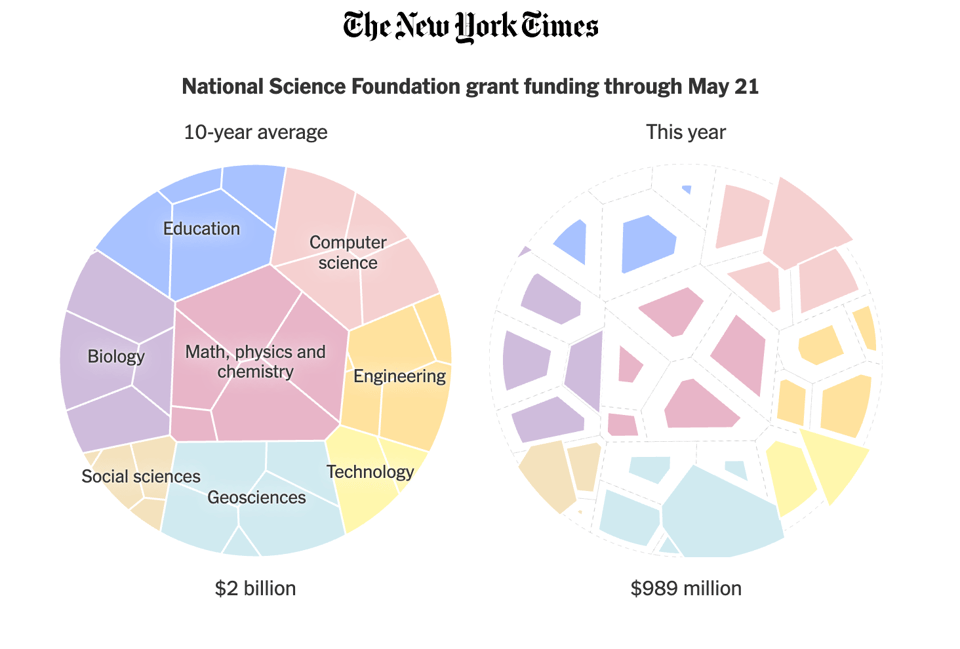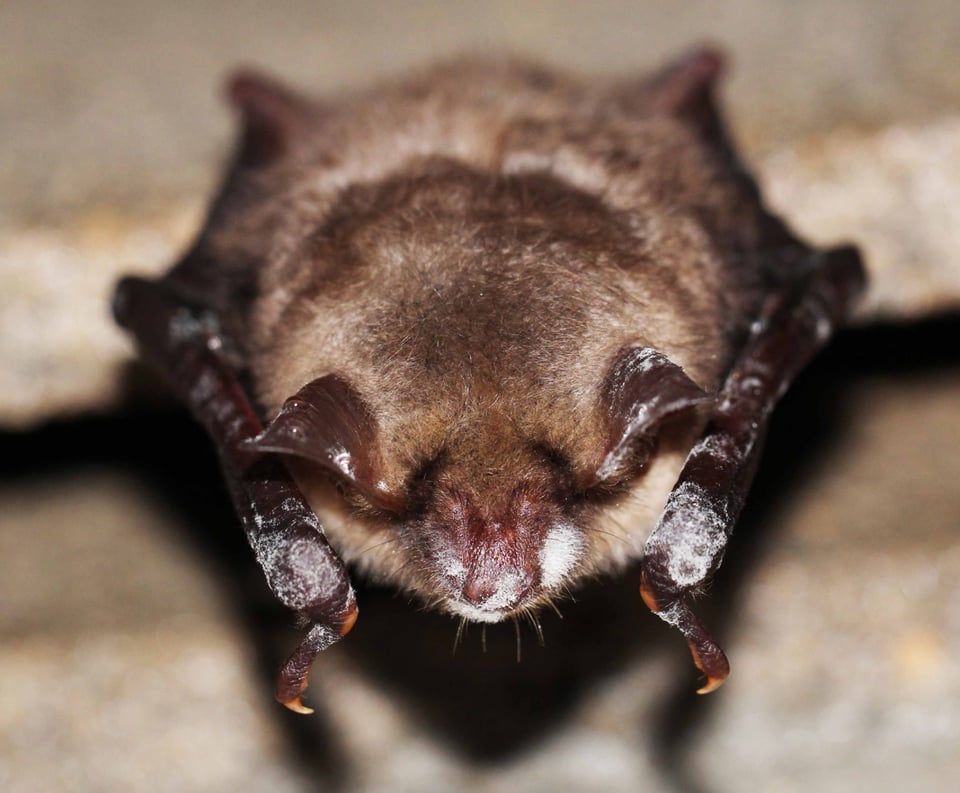
Lots to share today—from a podcast about biohacking to the lost women of science to The Last of Us…for bats.
But first I’d like to take a look at the ongoing earthquakes that are wracking American science and medicine. Sometimes an earthquake is just a scary tremor. And sometimes it takes down buildings, even whole neighborhoods.

The good folks at the Upshot at the New York Times used their visualization magic to illustrate the Trump administration’s cuts to science funding. This particular picture does a nice job of getting their point across, but the whole interactive experience—plus the reporting—is very much worth your time.
—That Upshot story looks specifically at the damage to American science over the past four months. More trouble is brewing for the future, as next year’s budget gets hashed out in Congress. The proposed budget from the Trump administration would make massive cuts not just to NSF but to all the other agencies that support science. For example, the National Institutes of Health would get cut by 40 percent. “If the proposal is enacted, Americans today and tomorrow will be sicker, poorer, and die younger,” one research advocate told STAT.
—The Trump administration has justified the cuts to NIH by claiming they will tackle chronic diseases. But it’s questionable how effective their efforts will be, despite all the fanfare around the “Make American Healthy Again” report that the administration released last week.
NOTUS—a news site staffed by young journalism fellows at the Allbritton Journalism Institute—discovered that a number of studies cited by the report simply don’t exist. Other footnotes cited real papers—but papers that have nothing to do with the claims in the report. Those and other clues suggest that whoever wrote it may have relied on AI rather than medical expertise. The Trump administration responded at first by claiming that these were “formatting errors” that did nothing to diminish the importance of the report. HHS released an updated version, and very soon the intrepid NOTUS team found a fresh round of errors.
If a college student had turned in this report as a paper, imagine the grade they would get for passing off such sloppy fabrications and mistakes. And bear in mind that this is what the Department of Health and Human Services is proudly offering after thousands of seasoned government workers, including scientists with lots of experience on things like chronic disease, were fired.
—HHS secretary Robert F. Kennedy, Jr., has made a series of announcements that could make it harder for people to get existing vaccines and for scientists to develop new ones. He announced that Covid vaccines would no longer be recommended for children, pregnant women, and healthy adults, ignoring scientific evidence and overriding the government’s process for making vaccine policy changes. The Trump administration also killed a $600 million grant to Moderna for research on mRNA bird flu vaccines, as well as a major effort to invent an HIV vaccine.
—Trump signed an executive order promoting “gold standard” science. Behind that label, scientists see a move to punish government researchers who come to politically inconvenient conclusions. In the Guardian, a group of scientists warned that the new policy smacks of Lysenko. (I talked about my worries about a resurgence of Lysenkoism in this 2017 speech.)
THE FUTURE OF AGING: BIOHACKING AMONG THE RICH AND POOR
This week the second episode of my podcast on aging came out. I take a close look at the science behind the biohacking craze—drugs like rapamycin that supposedly extend the human lifespan, or blood tests that can measure your biological age. Life extension has become a hobby of the affluent, but the actual science has a lot to tell us about how inequality causes some people to die sooner than others.
You can find the show by searching for “The World As You’ll Know It” wherever you get your podcasts. Here are links to this week’s episode on Spotify and on Apple.
THE ORIGIN OF A BAT PANDEMIC

If you live in North America, you see a lot fewer bats today than 20 years ago. That’s because a deadly fungus swept across the continent, causing white nose disease. It’s pushed some species towards extinction in the biggest animal mass mortality event ever recorded.
This week I wrote about a new study that pinpoints exactly where the disease came from: a few square miles of caves in western Ukraine. The researchers used some of the same techniques that I described recently in a study on the origin of SARS-CoV-2. A single spore, accidentally transported by a caver, might have started the disaster.
But the study has a warning about the future, too. Scientists have made some advances in the fight against the species that causes white nose disease, as I wrote last year. But it turns out that this one species is actually two. If we accidentally introduce the second species to North America, it could unleash a new bat pandemic of its own. At least this time we have been warned.
THE DISAPPEARING ALIENS
Last month I wrote about the discovery of a planet that just might have signs of life. I wasn’t surprised to see that story gain a huge numbers of readers. As the saying goes, big if true.
In the days that followed, other scientists looked closely at the data for themselves. And in three separate preprints, they’ve dismissed the initial results. The scientists who did the original study are standing by those results. Here’s my update on one of the most interesting debates in science at the moment.
IN MEMORY OF MILDRED WEEKS WELLS

I’m continuing to talk to podcasters about AIR-BORNE. One of the most interesting conversations I’ve had was with the folks at “Lost Women of Science.” I talked about unearthing the remarkable life of Mildred Weeks Wells, who worked with her husband William to document the threat airborne infection and find ways to fight it. Listen here.
That’s all for now. Stay safe!
You just read issue #191 of Friday's Elk. You can also browse the full archives of this newsletter.